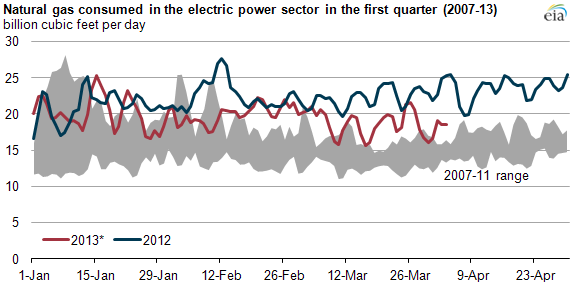People’s relationships with nature have always been complicated. Despite the fact that at present, the effects of various industries on environment have finally been discovered and that the ones that pose the greatest threat to nature have been labeled as harmful, the process of environmental destruction is still going on, mostly because the alternative sources of energy are either too costly or too inefficient.
Being one of the most popular energy sources, natural gas can still be considered a more useful energy source than coal, the production of which poses a considerable threat to the environment, often causes accidents at the mining sites, and leads to the emission of greenhouse gas.
The use of natural gas as the source for electricity production has a relatively long history. First used in the U.S. to light the streets of Baltimore in 1816, natural gas has been serving the purpose of providing electricity since then.
The first well was dug in 1859 by Colonel Edwin Dake. William Hart, as known as “the father of natural gas,” improved Dake’s construction by building his own well in 1821 and starting a Fredonia gas Light Company. At present, however, the use of natural gas as a source for electricity generation seems to have shrunken for numerous reasons. It is important to stress that at present, there are several basic locations of gas energy based electricity production plants. The key ones can be seen on the map below:

As the map shows, the key current locations of the U.S. electricity plants powered by gas are especially common along the east bank of Mississippi. The given choice is largely predetermined by the fact that a gas power plant requires considerable amounts of water for cooling and condensation purposes.
According to the chart provided by the USA, the drops in natural gas consumption can be explained by the rise in prices for gas, as the figure below shows. In 1891, the first pipeline construction was built, which led to creating a pipeline infrastructure. However, it was not until 60s that natural gas was finally used as the basic means to power electricity plants.

When it comes to defining the key construction and operation effects of power plants that use natural gas as the key resource, one must mention that the given plants have the following characteristics:
Construction:
- Gas engines: 1 to 20 MW;
- Control systems;
- SCADA systems;
- Tank farm;
- Pump house;
- Synchronous alterations;
and many other elements that provide an accurate and impeccable performance.
Speaking of the effects of a power plant that is run on natural gas, it is necessary to point out that the effects on the environment are drastic, as a rule, seeing how the use of gas contributes to the emission of CO2 and, thus, to the destruction of the ozone layer. Apart from the ozone layer issues, the fact that the water used for the temperature regulation issues becomes polluted very quickly as well, thus, leading to the death of numerous local endemics.
Apart from natural gas, the owners of power plants have another source of energy at their disposal; also defined as non-renewable, the given source is much more common, yet also much more harmful than natural gas. Coal, the production of which has been in existence since the early XVIII century, can be viewed as an alternative to a more expensive, rare and hard to obtain gas. To compare the effects of the two sources, the following parameters must be used:
Finally, it is necessary to consider an alternative source of energy. Since solar energy powered devices are not going to become a standard element of the household in the observable future, the opportunities offered by such source of energy as coal should be brought up. Indeed, this is a very powerful source – and, more to the point, a very common one.
Therefore, when making the choice between coal and natural gas as the means to generate energy for power plants, one must admit that natural gas, though being a comparatively more expensive source, has fewer disadvantages, leads to a lesser amount of negative outcomes and affects the environment to a lesser degree than coal, which is why it must be used more widely.
Even though natural gas admittedly wins in comparison to such resource as coal, it is still clear that using natural gas as an energy source has negative effects on environment, not to mention the fact that natural gas is a exhaustible resource and, therefore, will have to be substituted with a more suitable alternative sooner or later.
That being said, it is necessary to consider other energy sources, such as solar or wind power. Once taking the issues regarding the safety of nature, its species and its non-renewable resources, one can possibly contribute to building a better and safer future.
Works Cited
Bernstein, Lenny and Juliet Einperin. EPA moves to limit emissions of future coal- and gas-fired power plants.” The Washington Post. 2013. Web.
Schlissel, David, Allison Smith and Rachel Wilson. Coal-fired power plant construction costs. 2008. Web.
Natural gas consumed in the electric power sector in the first quarter (2007–2013) billion cubic feet per day 2013. Web.
U.S. power plant infrastructure. 2013. Web.